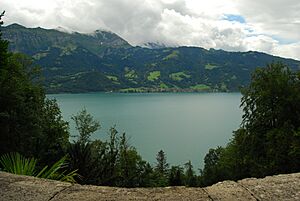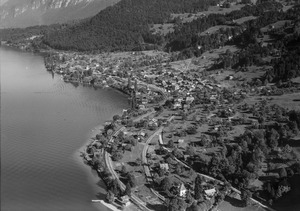Leissigen facts for kids
Quick facts for kids
Leissigen
|
||
|---|---|---|

Leissigen village church and mill
|
||
|
||
| Country | Switzerland | |
| Canton | Bern | |
| District | Interlaken-Oberhasli | |
| Area | ||
| • Total | 10.38 km2 (4.01 sq mi) | |
| Elevation | 575 m (1,886 ft) | |
| Population
(Dec 2020 )
|
||
| • Total | 1,171 | |
| • Density | 112.81/km2 (292.18/sq mi) | |
| Postal code |
3706
|
|
| Surrounded by | Därligen, Saxeten, Aeschi bei Spiez and Krattigen. | |
Leissigen is a lovely village in the canton of Bern, Switzerland. It's located in the Interlaken-Oberhasli administrative district. This charming municipality sits right on the beautiful Lake Thun, surrounded by stunning nature.
Contents
- What's in a Name? The Origin of Leissigen
- Leissigen Through Time: A Brief History
- Leissigen's Location: Geography and Landscape
- Leissigen's Symbol: The Coat of Arms
- Who Lives in Leissigen? Demographics
- How People Make a Living: Economy
- Beliefs and Faith: Religion
- Getting Around: Transport
- Learning and Schools: Education
- See also
- Images for kids
What's in a Name? The Origin of Leissigen
The name Leissigen comes from old German words. It combines the personal name Lantgis with -ingun. This means "of the people of Langtis."
Leissigen Through Time: A Brief History
Leissigen was first mentioned in official records way back in 1285. Back then, it was called Lensengne. A few years later, in 1290, it was known as Lenxingen.
- Early Settlements
The oldest signs of people living here are ancient tools. These include axes, daggers, and swords from the Bronze Age. This shows that people have lived in this area for a very long time.
- Medieval Times and Monastery Control
During the Middle Ages, Leissigen was part of an area called Unspunnen-Rotenfluh. Later, it was given to the Interlaken Monastery in 1334. The monastery controlled the village for almost 200 years.
- The Reformation and Bern's Influence
In 1528, the city of Bern changed its religion to Protestantism. Bern then tried to make everyone in the Bernese Oberland region follow this new faith. Leissigen, along with other villages, rebelled against this change. However, Bern eventually took control. The monastery was closed, and its lands, including Leissigen, became part of Bern.
- Village Churches
The first church in Leissigen was likely made of wood. It might have been built around the 7th or 8th century. This wooden church was later replaced by a stone building in the 9th or 10th century. An even newer stone church was built in the 11th century. This church was one of twelve churches around Lake Thun. The church building you see today was built after a big fire in 1675.
- Economy and Tourism
For a long time, the people of Leissigen relied on Lake Thun. Many villagers were fishermen or built boats. Others farmed the small areas of land between the lake and the mountains. Things started to change in 1780. A spa was built near mineral springs by the lake. Even though the springs dried up in 1873, a small tourist industry began. In 1887, a dock was built for steamships. These ships carried people and goods across the lake. Today, many jobs in Leissigen are in small businesses or summer tourism. About two-thirds of the working people travel to nearby Interlaken or Bern for their jobs.
Leissigen's Location: Geography and Landscape
Leissigen is located in the beautiful Bernese Oberland region. It stretches from the shore of Lake Thun up into the woods and mountains. The village itself includes the main settlement and some scattered farmhouses. The southern edge of the municipality reaches the Morgenberghorn mountain, which is about 2,249 meters (7,379 feet) high.
- Land Use
About 31.4% of Leissigen's land is used for farming. Forests cover a large part, about 52.0% of the area. Buildings and roads take up about 5.9% of the land. Rivers and lakes make up 1.0%, and 9.8% is unproductive land, like rocky areas.
- Meielisalp
High up in the mountains above the village, you'll find Meielisalp. This area has a lovely restaurant and hotel. It offers amazing views of the surrounding landscape.
- Administrative Changes
In 2010, Leissigen became part of a new administrative district. This new district is called Verwaltungskreis Interlaken-Oberhasli.
Leissigen's Symbol: The Coat of Arms
The coat of arms for Leissigen is quite simple but meaningful. It shows two fish swimming upwards, facing each other. The background is red. This design likely represents the village's historical connection to fishing in Lake Thun.
Who Lives in Leissigen? Demographics
Leissigen has a population of about 937 people (as of December 2010). Over the past ten years (2000-2010), the population has grown by about 9.9%. Most people in Leissigen speak German as their first language. A smaller number speak Albanian or French.
- Population Makeup
In 2008, about 50.2% of the population was male and 49.8% was female. Many people living in Leissigen were born there. Others were born in the same canton (Bern) or elsewhere in Switzerland. Some residents were born outside Switzerland.
- Age Groups
As of 2010, young people (ages 0-19) make up about 19% of the population. Adults (ages 20-64) are the largest group, at 60.4%. Seniors (over 64 years old) make up 20.6%.
- Homes and Households
In 2000, there were many different types of households. Some had only one person, while others had five or more people. Most apartments in Leissigen are lived in all year round.
- Population Growth Over Time
The population of Leissigen has changed over the years. For example, in 1764, there were about 250 people. By 2000, the population had grown to 898 people.
How People Make a Living: Economy
In 2011, Leissigen had a low unemployment rate of 1.6%. This means most people who wanted to work had jobs.
- Types of Jobs
In 2008, there were 240 people working in Leissigen.
- Primary Sector: About 21 people worked in the primary sector. This includes jobs like farming and fishing.
- Secondary Sector: About 58 people worked in the secondary sector. These jobs involve making things, like in manufacturing or construction.
- Tertiary Sector: The largest group, 161 people, worked in the tertiary sector. This includes jobs in services, like hotels, restaurants, retail, and healthcare.
- Commuting
Many people who live in Leissigen travel to other towns for work. In 2000, about 297 workers commuted out of the municipality. About 21.1% of working people used public transportation to get to their jobs, while 49.1% used a private car.
Beliefs and Faith: Religion
Based on a 2000 survey, most people in Leissigen belonged to the Swiss Reformed Church. A smaller number were Roman Catholic or belonged to other Christian churches. Some people were Islamic, and a few belonged to other religions. There were also people who did not belong to any church.
Getting Around: Transport
Leissigen has regular bus services. These buses connect the village to nearby towns like Spiez and Interlaken. In the past, Leissigen also had a train station on the Lake Thun line.
Learning and Schools: Education
In Leissigen, many adults have completed higher education. This means they have gone to a university or a specialized college.
- School System
The school system in the Canton of Bern works like this:
- One year of non-mandatory Kindergarten.
- Six years of Primary school.
- Three years of obligatory lower Secondary school. In secondary school, students are grouped by their abilities.
After lower secondary school, students can choose to continue their education or start an apprenticeship (learning a trade on the job).
- Students in Leissigen
During the 2010–11 school year, 77 students attended classes in Leissigen. There was one kindergarten class with 14 students. The village also had three primary classes with 58 students. A small number of these primary students had a different first language than the classroom language. There was also one lower secondary class with 5 students.
See also
 In Spanish: Leissigen para niños
In Spanish: Leissigen para niños
Images for kids







